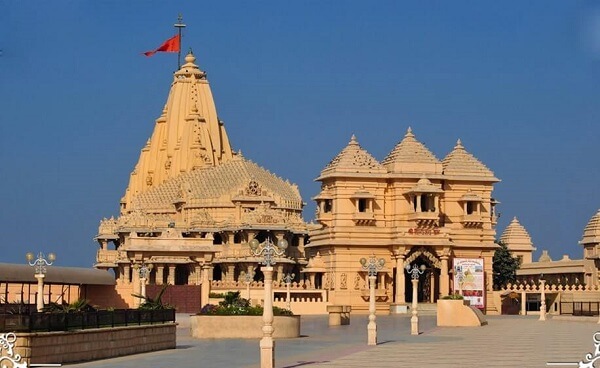Somnath Jyotirlinga in Gujarat: The Eternal Abode of Lord Shiva
Nestled along the pristine shores of the Arabian Sea in Prabhas Patan, Gujarat, the Somnath Jyotirlinga stands as a timeless testament to faith, resilience, and divine grace. Revered as the first among the 12 Jyotirlingas, this sacred shrine embodies Lord Shiva’s cosmic light (jyoti) and holds a unique place in Hindu spirituality. For centuries, pilgrims, historians, and seekers have been drawn to Somnath, not only for its religious significance but also for its rich history of destruction and rebirth. In this comprehensive guide, we delve into the legends, architecture, rituals, and enduring legacy of Somnath in Gujarat, offering a deep dive into one of India’s most iconic spiritual landmarks.
The Legend of Somnath Jyotirlinga: Mythology and Significance
The Curse of Chandra and Shiva’s Benevolence
The origins of Somnath are steeped in the ancient lore of the Shiva Purana and Skanda Purana. According to legend, the moon god Chandra, married to Daksha Prajapati’s 27 daughters (the Nakshatras), favored one wife, Rohini, over the others. Enraged, Daksha cursed Chandra to wane into obscurity. Desperate, Chandra meditated at Prabhas Patan, where Lord Shiva appeared and partially lifted the curse, ensuring the moon waxed and waned cyclically. Grateful, Chandra built a golden temple in Shiva’s honor, naming it Somnath (“Lord of the Moon”).
Somnath in Hindu Scriptures
Somnath is hailed as “Prabhas Kshetra,” a land where the divine and mortal realms intersect. The Rigveda and Mahabharata reference this site as a place of spiritual awakening. It is also linked to Lord Krishna, who is believed to have departed to his heavenly abode near Somnath.
A Temple Reborn: The Turbulent History of Somnath
Somnath’s history is a saga of devotion and destruction, with the temple being looted and rebuilt at least 17 times over 1,500 years.
The Glory of Ancient Somnath
- Early Construction (Unknown Era): The original temple, said to be made of gold by Chandra, was later rebuilt in silver by Ravana, in wood by Krishna, and in stone by the Yadava kings.
- The Gurjara-Pratihara Era (8th–9th Century CE): The temple flourished as a center of wealth and spirituality, attracting pilgrims from Arabia and Europe.
Invasions and Resilience
- Mahmud of Ghazni’s Raid (1026 CE): The Turkic invader looted the temple’s jewels and destroyed its linga, marking the first major desecration.
- Subsequent Attacks: The temple faced raids by Alauddin Khilji’s general (1299 CE), Muzaffar Shah I (1375 CE), and Aurangzeb (1706 CE). Each time, local rulers and devotees rebuilt it.
The Modern Resurrection
- Sardar Patel’s Vision (1947): India’s first Deputy Prime Minister vowed to rebuild Somnath as a symbol of national pride.
- Reconstruction (1951): Under architect Prabhashankar Sompura, the current temple rose in the Chalukya-Kshatrapa style, blending ancient and modern design.
Architectural Grandeur: Exploring the Temple’s Design
The present-day Somnath Temple is a marvel of Indian architecture, reflecting Gujarat’s cultural heritage.
Key Features
- Spire (Shikhar): A 15-meter-tall spire adorned with intricate carvings of gods, goddesses, and celestial beings.
- Mandapa and Garbhagriha: The pillared hall leads to the sanctum, housing the Jyotirlinga—a 3-foot-tall stone linga radiating spiritual energy.
- Location: Perched on the Arabian Sea coast, the temple offers panoramic views, especially during sunrise and sunset.
Symbolism in Stone
- The temple’s alignment allows the first rays of the sun to fall directly on the linga.
- Sculptures depict scenes from Hindu epics, including the Ramayana and Shiva Tandava.
Spiritual Practices and Rituals at Somnath
Daily Rituals
- Mangla Aarti (5 AM): The day begins with hymns and lamp offerings as the temple doors open.
- Shringar Darshan (7 AM): The linga is adorned with flowers and ornaments.
- Sandhya Aarti (7 PM): Devotees gather for the evening ceremony, accompanied by conch shells and bells.
Festivals
- Maha Shivaratri: Thousands fast and chant Om Namah Shivaya through the night.
- Kartik Purnima: Pilgrims take a holy dip in the Triveni Sangam (confluence of Hiran, Kapila, and Saraswati rivers).
Visitor’s Guide to Somnath in Gujarat
How to Reach
- By Air: The nearest airport is Diu (90 km away).
- By Rail: Somnath Railway Station (1 km) connects to Ahmedabad and Rajkot.
- By Road: Well-connected via NH51 and state highways.
Best Time to Visit
- October–March: Pleasant weather (20–28°C).
- Monsoon (July–September): Lush greenery but heavy rainfall.
Accommodation
- Gujarat Tourism Hotels: The Lords Inn Somnath and nearby guesthouses offer budget-friendly stays.
- Dharamshalas: Affordable options for pilgrims.
Nearby Attractions
- Bhalka Tirth: The spot where Lord Krishna was mistakenl shot by a hunter.
- Veraval Beach: A serene escape 6 km from the temple.
- Junagadh Gate: A historical monument from the Mughal era.
Somnath Today: A Beacon of Cultural Revival
The temple’s restoration in 1951 marked a resurgence of Indian heritage. Today, it’s managed by the Somnath Trust, which also runs a museum showcasing artifacts from its tumultuous past. The Sound and Light Show (7:45 PM daily) narrates the temple’s history in Gujarati, Hindi, and English.
Why Somnath in Gujarat is a Must-Visit
- Spiritual Solace: Feel the palpable energy of the Jyotirlinga during aarti.
- Historical Insight: Explore the museum’s collection of ancient coins, pottery, and scriptures.
- Natural Beauty: Watch the waves of the Arabian Sea merge with hymns at the Triveni Ghat.

